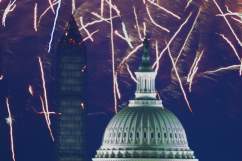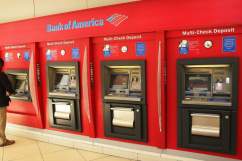One of the most important documents in American history is the Declaration of Independence. The document provided a way for the colonies to separate themselves publically from England. It would serve as a foundation for the establishment of the United States. While it is a well known historical document, the majority of the American public may not be familiar with some of the context regarding the Declaration of Independence. Here are some highlights regarding the document that you may not know:
1. A Committee of 5 Men Wrote the Declaration of Independence

Benjamin Franklin drafting the Declaration of Independence with Thomas Jefferson, John Adams, Roger Sherman and Robert R Livingstone. (Getty)
According to History.com, a five-man committee was appointed by the Continental Congress to create the Declaration of Independence. The committee was comprised of Thomas Jefferson of Virginia, Roger Sherman of Connecticut, Robert Livingston of New York, Benjamin Franklin of Pennsylvania and John Adams of Massachusetts.
The group tasked Thomas Jefferson with creating the first draft. The original version that was given to congress contained a passage condemning Great Britain for introducing the slave trade to America. Congress did not accept this portion of the declaration. You can read the full version of the final Declaration of Independence here.
2. The Vote for the Declaration Took Place on July 2, 1776

Fireworks light up the sky over the Lincoln Memorial, Washington Monument, and the U.S. Capitol. (Getty)
July 4th is the annual holiday where Americans have traditionally celebrated our country’s independence. According to archives.gov, it was actually July 2nd that the Declaration of Independence was voted on. The document was not actually signed until August 2nd.
John Adams anticipated that July 2nd would become a national holiday. In a letter to his wife, Abigail, John Adams penned these words:
The second day of July, 1776, will be the most memorable epocha in the history of America. I am apt to believe that it will be celebrated by succeeding generations as the great anniversary festival. It ought to be commemorated, as the day of deliverance, by solemn acts of devotion to God Almighty. It ought to be solemized with pomp and parade, with shows, games, sports, guns, bells, bonfires, and illuminations, from one end of this continent to the other, from this time forward, forevermore.”
3. John Hancock Signed His Name First
When people think of the Declaration of Independence, John Hancock is often the first name that comes to mind. Hancock was born in Massachusetts and served as the president of the Continental Congress. There are various versions of the story and some doubt its accuracy.
However, it is widely believed that Hancock was the first person to sign the Declaration of Independence. According to History.com, he signed his name largely so that the king of England would be able to read it. Today, it is common practice to refer to someone’s signature as their “John Hancock.” A total of 56 people signed the document in Philadelphia, Pennsylvania.
4. The Declaration of Independence Separated the Colonies and Great Britain
According to Sparknotes.com, the document served a few purposes. One was for the 13 colonies to declare themselves separate from England, meaning they were essentially declaring war on Great Britain. It also served as a way to get aid from foreign countries. For example, the document allowed the colonies to have an alliance with France. The French assisted the colonies in the war against Great Britain.
5. The Original Document is Displayed at the National Archives Building

The first newspaper printing of the Declaration of Independence printed in The Pennsylvania Evening Post. (Getty)
The original Declaration of Independence can be seen at the National Archives Building in Washington, D.C. In addition to visiting the document in person, there is also an online exhibit that allows anyone to view online images of the original copy.
Few people know that there were actually a select number of copies made of the document. There are an estimated 25 copies remaining of the Dunlap Copies. These were originally copies that were passed throughout the colonies after the Declaration of Independence was agreed upon.


